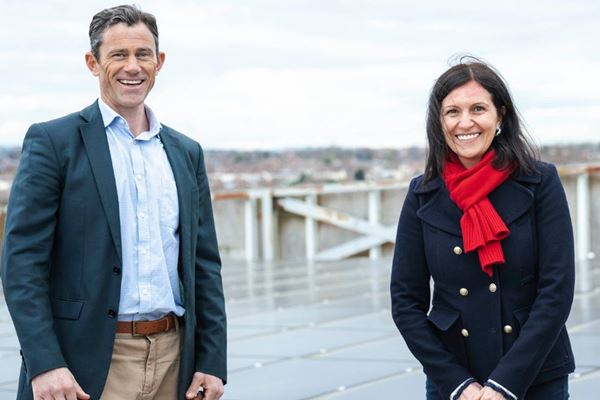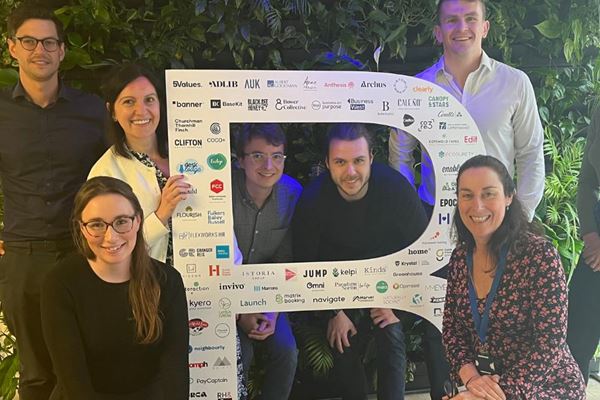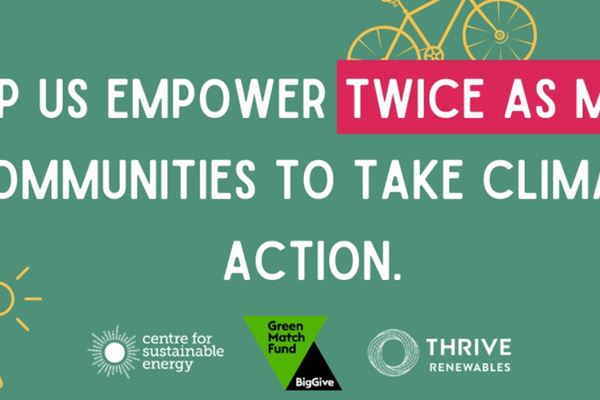“The power of technology is transformational. Advances in the most mature renewables means that in many markets we can already generate low carbon electricity without additional costs. Advances in enabling technologies and market innovations including energy storage, demand side aggregation and big data mean that the majority of our electricity can be generated by renewables in the decades ahead, even when the wind doesn’t blow or the sun fails to shine.” - Colin Morgan, Founder of Everoze and Thrive Board Member
Colin will tell you that he likes nothing more than spending time with his two teenage sons, whether it’s watching an action movie, walking the dog or splashing around at the coast, he knows that life can pass all too quickly. With a career in wind energy spanning more than two decades, Colin has seen his fair share of developments including the turbulent beginnings of the 80s Californian wind boom, the building of Europe’s biggest onshore windfarm in 1994, with 103 turbines on a hilltop just outside Newtown in Powys, and to present day, where he leads a multi-national team committed to being part of the solution that drives to take carbon and international politics out of our energy supply.
Colin, a keen cyclist, bypassed the traffic to our Thrive office to spend some time talking about his career, renewables, the importance of time with family, cycling and love of everything that Bristol has to offer.
COLIN, TELL US HOW YOU GOT INTO RENEWABLES AND SPECIFICALLY WIND ENERGY
“My education went down the traditional engineering route. I’ve been interested in energy since the age of 15 and upon taking a geography O’Level my interest grew in clean energy. By the time I went to university the next step was a degree in Mechanical Engineering in London. Soon after leaving Uni, I happened upon a small start-up in wind energy called Garrad Hassan, and joined them. The move was intended to be temporary, partly to stay and experience London for another year as renewables back then was not considered to be a real career, most of my peers joining aerospace, automotive, accountancy or chemical companies. I ended up staying there 28 years!”
The company grew and ultimately merged into DNV GL, which operates worldwide as one of the leading engineering certification, safety and consultancy businesses. By 2015 Colin was a Senior VP there having held various roles including being globally responsible for the company’s offshore wind business and manager of the 400-strong business unit providing renewables consulting across Western Europe and Latin America. In July 2015 he left with five colleagues to found Everoze, still focused on the remit around clean energy, including wind and solar, but also storage and potentially wider power and energy system issues. Everoze has grown quickly to 25 staff in UK and France, advising investors, developers, operators and policy-makers in renewables and storage; by leveraging their extensive industry network and deep technical understanding.
“It’s nice to be doing engineering again and delivering projects. Our ethical drive is to take carbon out of our energy system, so we’re trying hard to maintain an enjoyable work environment, but we are still making a meaningful impact.” This motivation and ethos has made Colin a successful transformational leader.
WHAT'S YOUR EXPERIENCE OF HOW THE INDUSTRY HAS CHANGED OVER THE YEARS?
“Back when I started out in 1987, it wasn’t about carbon, people had an awareness of fossil fuels polluting, but climate change was not really on the agenda. It was about sustainability of supply. Wind energy was seen back then as a cottage industry. It began with a flurry of activity in California. Wind farms were manufactured in all sorts of shapes and sizes by a huge range of companies, most of which went bust, but a couple survived and are still here today. This drove a lot of wind energy to be installed, and a lot of painful lessons to be learnt. Some of my earliest work was in understanding those lessons and feeding it into the next phase of the industry which happened in Europe.
The plus point was an injection of interest in wind and investment to get the sector through its early growing pains. By the early 90’s UK, Denmark and Germany had developed a market which supported construction of new wind farms, and there was significant UK-based manufacture going on. However, the UK market waned in the mid 90’s as the Government ‘dash for gas’ policy dominated, which is a major reason why the dominant turbine suppliers today are from Germany and Denmark. It simply took too long to get a reliable market started in the UK. That happened in 2002/3 when the Renewables Obligation support mechanism started. From that point until 2015, the UK provided policy support which was as consistent as anywhere in the world hence why we’ve seen over a decade of massive growth in renewable power on our system at new-build prices which have now pretty much closed the gap on conventional generation options. If we look at the power capacity that is being installed now, renewables is a major player and in many parts of the world, including Europe, dominant.”
WHAT'S YOUR PREDICTION FOR RENEWABLES AND THE ENERGY SYSTEM?
“The most exciting development in renewables is the cost coming down and it being a time where renewables are the rational economic choice against conventional generators without any kind of subsidy. Where competition has been introduced new renewable projects have been developed significantly more cheaply signalling that the time is right to move towards a competitive model, where renewables compete with each other and non-renewables. This is happening globally. In the UK we’re currently on the path to a generation mix which is heavily gas based and I’m confident that new onshore wind projects can be cost competitive with new Combined Cycle Gas Turbines (CCGTs). Large-scale solar PV in the south of the UK is not far behind and energy from offshore wind is also getting sharply cheaper.
CCGT is much cleaner than coal, but still generating carbon. We hear a lot about Carbon Capture and Storage, but that is some way from being commercial. Just as the main market mechanism for onshore wind and solar PV was stalled by the incoming 2015 UK Government, so there is no effective market mechanism at present to trigger new-build of CCGTs. Onshore wind projects being built now are happening because of legacy arrangements. In this context, the decision to go ahead and build Hinckley is an irrelevance (as well as being economically irrational). With old plants being retired from the system, near-term action is needed to keep the lights on from around 2020.
So, while we are in something of a policy vacuum, necessity dictates that the Government must bring forward policies in the next year or so to promote building of further new generation capacity. Provided that economic rationality and the interests of the electricity consumer figure significantly in those policies, they should result in a substantial and potentially dominant proportion of our new generators being renewable. Those renewable generators are most likely to be onshore wind projects in Scotland, because it’s more supportive in terms of planning, windier and has space for larger more cost-effective projects than in England and Wales.
But crucially, we are at the point where national policy to build renewables stops being a fluffy environmental decision that needs subsidy support – it is the low cost option for the consumer.
And what about when the wind doesn’t blow and the sun doesn’t shine? My view of a future system is a move towards wind increasing onshore and offshore, with more solar in the South, increased electrical interconnection with Europe, a lot more storage plant distributed around the country and more flexible control of demand - having more active control of our consumption – identifying what power can be turned off safely and without the consumer even noticing.”
WHAT WILL PEOPLE THINK IN THE FUTURE WHEN WE LOOK BACK AT ALL THIS?
“Coming from a situation where as a nation we have used a few large remote power stations to power the grid for over 100 years, it has disconnected people entirely from where they get their electricity. Most people have no idea of how our electricity system works. Go back a few generations, what were the first things people did in the morning – find water, find fuel, find food – how many people today think about how to get their fuel? We’ve had to make no compromises in our lives to make that happen other than paying the bills. In the future if we want clean cost-effective power, we have to accept the compromise that the source of that power is not invisible. So in the future I’d like to think that renewable energy will be as widely accepted in our environment as the entirely man-made agricultural landscape is today. It is essential that renewables win that social acceptance, which will be by being good neighbours, by education and by people having ownership. That ownership may be real, as Thrive offers, or it may be the kind that people feel towards familiar features – like the Victorian mill you always passed by on the way to school.
People will also wonder why we were so profligate in how we used energy, so improving efficiency is non-negotiable and the stakes are increasing. We’ve got a future in which it is likely transport and heat will be electrified. We’re already at 25% of electricity being generated from renewables in UK, which is great, but as we electrify the wider energy system in the long-term our electricity demand can only go up. That’s why there is such a pressing need to sort out electricity generation – to break the link between electricity and carbon dioxide production and to do so without increasing the cost to the consumer.
So we know where we need to get to and it’s about getting there as fast as we can. We’ll need technology development, cost reduction and social acceptance, but there’s every reason to be optimistic.”
ABOUT COLIN MORGAN
- Chartered Mechanical Engineer with over 29 years in the wind energy industry,
- Non-Executive Director of Thrive Renewables PLC since 2013, sitting on the Operations Health & Safety Sub-Committee
- Senior VP / Regional Manager for DNV GL (Western Europe & Latin America ), 2013-2015, one of the largest, most respected, renewable advisory teams in the world;
- Global Head of Offshore Wind for the GL Group 2011-2013;
- Chaired Renewable UK Onshore Wind Cost Reduction Task-force 2014/15.
Founder of Everoze (2015) - a business committed to being part of the solution as they drive to take carbon and international politics out of our energy supply. Client-focused technical experts across the renewable energy sector.



